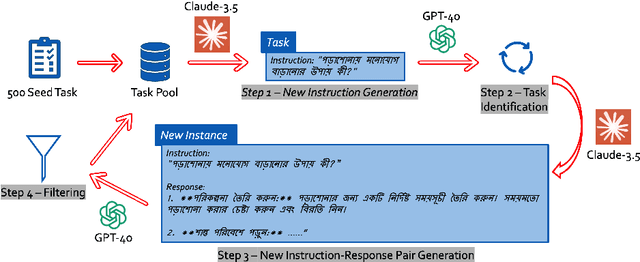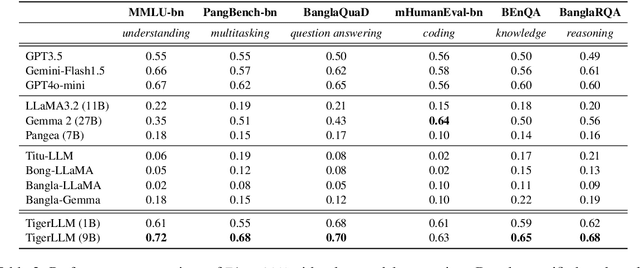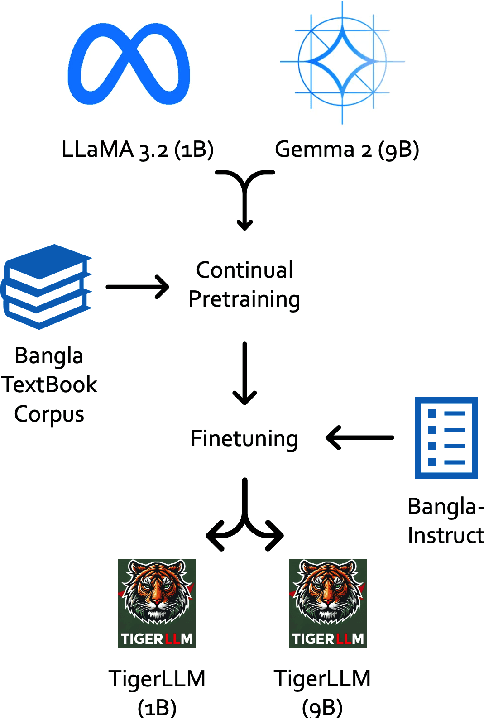Marcos Zampieri
TigerCoder: A Novel Suite of LLMs for Code Generation in Bangla
Sep 11, 2025Abstract:Despite being the 5th most spoken language, Bangla remains underrepresented in Large Language Models (LLMs), particularly for code generation. This primarily stems from the scarcity of high-quality data to pre-train and/or finetune such models. Hence, we introduce the first dedicated family of Code LLMs for Bangla (1B & 9B). We offer three major contributions: (1) a comprehensive Bangla code instruction datasets for programming domain adaptation; (2) MBPP-Bangla, an evaluation benchmark for Bangla code generation; and (3) the TigerCoder-family of Code LLMs, achieving significant ~11-18% performance gains at Pass@1 over existing multilingual and general-purpose Bangla LLMs. Our findings show that curated, high-quality datasets can overcome limitations of smaller models for low-resource languages. We open-source all resources to advance further Bangla LLM research.
Narrate2Nav: Real-Time Visual Navigation with Implicit Language Reasoning in Human-Centric Environments
Jun 17, 2025Abstract:Large Vision-Language Models (VLMs) have demonstrated potential in enhancing mobile robot navigation in human-centric environments by understanding contextual cues, human intentions, and social dynamics while exhibiting reasoning capabilities. However, their computational complexity and limited sensitivity to continuous numerical data impede real-time performance and precise motion control. To this end, we propose Narrate2Nav, a novel real-time vision-action model that leverages a novel self-supervised learning framework based on the Barlow Twins redundancy reduction loss to embed implicit natural language reasoning, social cues, and human intentions within a visual encoder-enabling reasoning in the model's latent space rather than token space. The model combines RGB inputs, motion commands, and textual signals of scene context during training to bridge from robot observations to low-level motion commands for short-horizon point-goal navigation during deployment. Extensive evaluation of Narrate2Nav across various challenging scenarios in both offline unseen dataset and real-world experiments demonstrates an overall improvement of 52.94 percent and 41.67 percent, respectively, over the next best baseline. Additionally, qualitative comparative analysis of Narrate2Nav's visual encoder attention map against four other baselines demonstrates enhanced attention to navigation-critical scene elements, underscoring its effectiveness in human-centric navigation tasks.
A Survey on Multilingual Mental Disorders Detection from Social Media Data
May 21, 2025Abstract:The increasing prevalence of mental health disorders globally highlights the urgent need for effective digital screening methods that can be used in multilingual contexts. Most existing studies, however, focus on English data, overlooking critical mental health signals that may be present in non-English texts. To address this important gap, we present the first survey on the detection of mental health disorders using multilingual social media data. We investigate the cultural nuances that influence online language patterns and self-disclosure behaviors, and how these factors can impact the performance of NLP tools. Additionally, we provide a comprehensive list of multilingual data collections that can be used for developing NLP models for mental health screening. Our findings can inform the design of effective multilingual mental health screening tools that can meet the needs of diverse populations, ultimately improving mental health outcomes on a global scale.
SCALAR: A Part-of-speech Tagger for Identifiers
Apr 23, 2025Abstract:The paper presents the Source Code Analysis and Lexical Annotation Runtime (SCALAR), a tool specialized for mapping (annotating) source code identifier names to their corresponding part-of-speech tag sequence (grammar pattern). SCALAR's internal model is trained using scikit-learn's GradientBoostingClassifier in conjunction with a manually-curated oracle of identifier names and their grammar patterns. This specializes the tagger to recognize the unique structure of the natural language used by developers to create all types of identifiers (e.g., function names, variable names etc.). SCALAR's output is compared with a previous version of the tagger, as well as a modern off-the-shelf part-of-speech tagger to show how it improves upon other taggers' output for annotating identifiers. The code is available on Github
Subasa -- Adapting Language Models for Low-resourced Offensive Language Detection in Sinhala
Apr 02, 2025



Abstract:Accurate detection of offensive language is essential for a number of applications related to social media safety. There is a sharp contrast in performance in this task between low and high-resource languages. In this paper, we adapt fine-tuning strategies that have not been previously explored for Sinhala in the downstream task of offensive language detection. Using this approach, we introduce four models: "Subasa-XLM-R", which incorporates an intermediate Pre-Finetuning step using Masked Rationale Prediction. Two variants of "Subasa-Llama" and "Subasa-Mistral", are fine-tuned versions of Llama (3.2) and Mistral (v0.3), respectively, with a task-specific strategy. We evaluate our models on the SOLD benchmark dataset for Sinhala offensive language detection. All our models outperform existing baselines. Subasa-XLM-R achieves the highest Macro F1 score (0.84) surpassing state-of-the-art large language models like GPT-4o when evaluated on the same SOLD benchmark dataset under zero-shot settings. The models and code are publicly available.
Datasets for Depression Modeling in Social Media: An Overview
Mar 27, 2025



Abstract:Depression is the most common mental health disorder, and its prevalence increased during the COVID-19 pandemic. As one of the most extensively researched psychological conditions, recent research has increasingly focused on leveraging social media data to enhance traditional methods of depression screening. This paper addresses the growing interest in interdisciplinary research on depression, and aims to support early-career researchers by providing a comprehensive and up-to-date list of datasets for analyzing and predicting depression through social media data. We present an overview of datasets published between 2019 and 2024. We also make the comprehensive list of datasets available online as a continuously updated resource, with the hope that it will facilitate further interdisciplinary research into the linguistic expressions of depression on social media.
TigerLLM -- A Family of Bangla Large Language Models
Mar 14, 2025



Abstract:The development of Large Language Models (LLMs) remains heavily skewed towards English and a few other high-resource languages. This linguistic disparity is particularly evident for Bangla - the 5th most spoken language. A few initiatives attempted to create open-source Bangla LLMs with performance still behind high-resource languages and limited reproducibility. To address this gap, we introduce TigerLLM - a family of Bangla LLMs. Our results demonstrate that these models surpass all open-source alternatives and also outperform larger proprietary models like GPT3.5 across standard benchmarks, establishing TigerLLM as the new baseline for future Bangla language modeling.
Code LLMs: A Taxonomy-based Survey
Dec 11, 2024



Abstract:Large language models (LLMs) have demonstrated remarkable capabilities across various NLP tasks and have recently expanded their impact to coding tasks, bridging the gap between natural languages (NL) and programming languages (PL). This taxonomy-based survey provides a comprehensive analysis of LLMs in the NL-PL domain, investigating how these models are utilized in coding tasks and examining their methodologies, architectures, and training processes. We propose a taxonomy-based framework that categorizes relevant concepts, providing a unified classification system to facilitate a deeper understanding of this rapidly evolving field. This survey offers insights into the current state and future directions of LLMs in coding tasks, including their applications and limitations.
A Survey of Multimodal Sarcasm Detection
Oct 24, 2024



Abstract:Sarcasm is a rhetorical device that is used to convey the opposite of the literal meaning of an utterance. Sarcasm is widely used on social media and other forms of computer-mediated communication motivating the use of computational models to identify it automatically. While the clear majority of approaches to sarcasm detection have been carried out on text only, sarcasm detection often requires additional information present in tonality, facial expression, and contextual images. This has led to the introduction of multimodal models, opening the possibility to detect sarcasm in multiple modalities such as audio, images, text, and video. In this paper, we present the first comprehensive survey on multimodal sarcasm detection - henceforth MSD - to date. We survey papers published between 2018 and 2023 on the topic, and discuss the models and datasets used for this task. We also present future research directions in MSD.
MojoBench: Language Modeling and Benchmarks for Mojo
Oct 23, 2024Abstract:The recently introduced Mojo programming language (PL) by Modular, has received significant attention in the scientific community due to its claimed significant speed boost over Python. Despite advancements in code Large Language Models (LLMs) across various PLs, Mojo remains unexplored in this context. To address this gap, we introduce MojoBench, the first framework for Mojo code generation. MojoBench includes HumanEval-Mojo, a benchmark dataset designed for evaluating code LLMs on Mojo, and Mojo-Coder, the first LLM pretrained and finetuned for Mojo code generation, which supports instructions in 5 natural languages (NLs). Our results show that Mojo-Coder achieves a 30-35% performance improvement over leading models like GPT-4o and Claude-3.5-Sonnet. Furthermore, we provide insights into LLM behavior with underrepresented and unseen PLs, offering potential strategies for enhancing model adaptability. MojoBench contributes to our understanding of LLM capabilities and limitations in emerging programming paradigms fostering more robust code generation systems.
 Add to Chrome
Add to Chrome Add to Firefox
Add to Firefox Add to Edge
Add to Edge